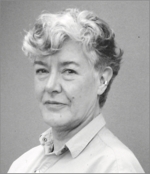Dr Patricia Rebbeck, 1934–2017
Born in Ipswich, England, on 2 November 1934, Dr Patricia Rebbeck grew up in a happy English family.

Born in Ipswich, England, on 2 November 1934, Dr Patricia Rebbeck grew up in a happy English family. Her father’s engineering career required the family to move frequently and as a consequence Pat attended four secondary schools within Britain. The family then moved to Australia where, as a keen student, she began her undergraduate education in both Perth and Adelaide. She returned to Britain to complete her medical training in Edinburgh, which she completed with honors in 1959. By that point her parents had moved to Montreal, and to be near them she decided to do her internship there. She pursued a surgical career but found there were no positions in Montreal. She was accepted in Vancouver and completed her residency in general surgery in 1966. She took a break from her training to do general practice in Wales, but decided the NHS was not to her liking and returned to Vancouver to complete her surgical residency. She achieved several firsts within the medical profession, starting with being the first female general surgeon to graduate in British Columbia and the fourth within Canada. She became the first woman president of the VMA in 1979, and, later, the first female member of the College Board in 1991.
She began her surgical career at St. Vincent’s Hospital and remained on staff there until her retirement from surgery in 1993. During her career, her interests quickly evolved to breast diseases and melanoma while she continued to work in general surgery. Her energy and enthusiasm were boundless and she was asked to join the staff at the newly built UBC Hospital in 1980. There she began an academic and teaching career, eventually becoming a clinical associate professor and honorary member of the medical alumni in 2003 as well as professor emerita. She excelled at teaching, winning an award for best undergraduate teacher in 1989. She gave lectures at both the provincial and national level focusing on breast cancer and physician support, misconduct, and ethics.
As if that were not enough, she also held the position of office president of the College Board in 1991. She had been heavily involved in the Federation of Medical Women of Canada, and served as president of the British Columbia branch in 1973. She was the first woman on the Editorial Board of the BCMJ (a position she held for over 27 years), a district representative to the BCMA, and on multiple committees at the BCCA, especially those relating to breast cancer, mammography breast screening, quality care, and research. Her collaboration with UBC and BCCA researchers resulted in the publication of multiple academic articles pertaining to breast cancer treatment.
She continued to collect awards throughout her career, including the YWCA Women of Distinction Award in Health Sciences and Technology in 1986, and in the same year she gave the Osler lecture to the VMA. She received a Prince of Good Fellows Award from the VMA in 1983.
Pat was always trying to improve treatments and quality of care. She was never troubled by the need to overcome obstacles and ranted against illogical or fixed ideas. For example, in the surgical treatment of breast cancer, partial mastectomy is now the primary recommendation as opposed to removing the whole breast. Pat was one of the first surgeons in British Columbia to perform this operation, resulting in a huge improvement for patient aesthetic outcomes. She was among one of the first physicians in BC to promote the benefits of screening mammograms, breast ultrasound, and neoadjuvant chemotherapy, always encouraging new techniques. These are now treatments we take for granted. The empathy, mentoring of physicians, and pursuit of excellence in her work made her stand out, and her compassion is evidenced in how much her patients loved her.
She was also a person who embraced leisure, and always expressed a love of the sea. For many years there was a kayak on the top of her truck. She was an avid gardener, and was also involved in the support of early music.
When she felt she could no longer continue with a surgical career due to severe arthritis in her hands, she became a deputy registrar at the College. She continued to work for the College in many capacities until her final retirement. Her last years were troubled by health issues, but these did not dampen her humor and pragmatism.
Today there are many practising women surgeons, but this has not always been the case. Pat was a trail blazer and pioneer for all women in this regard, and it is how she should be remembered. She was a surgeon with a generous nature and was witty and wise. She was also a mentor and a teacher for many students, doctors, and nurses. Hers was a life of firsts, of the best and accomplished kind.
—Urve Kuusk, MD
Vancouver
